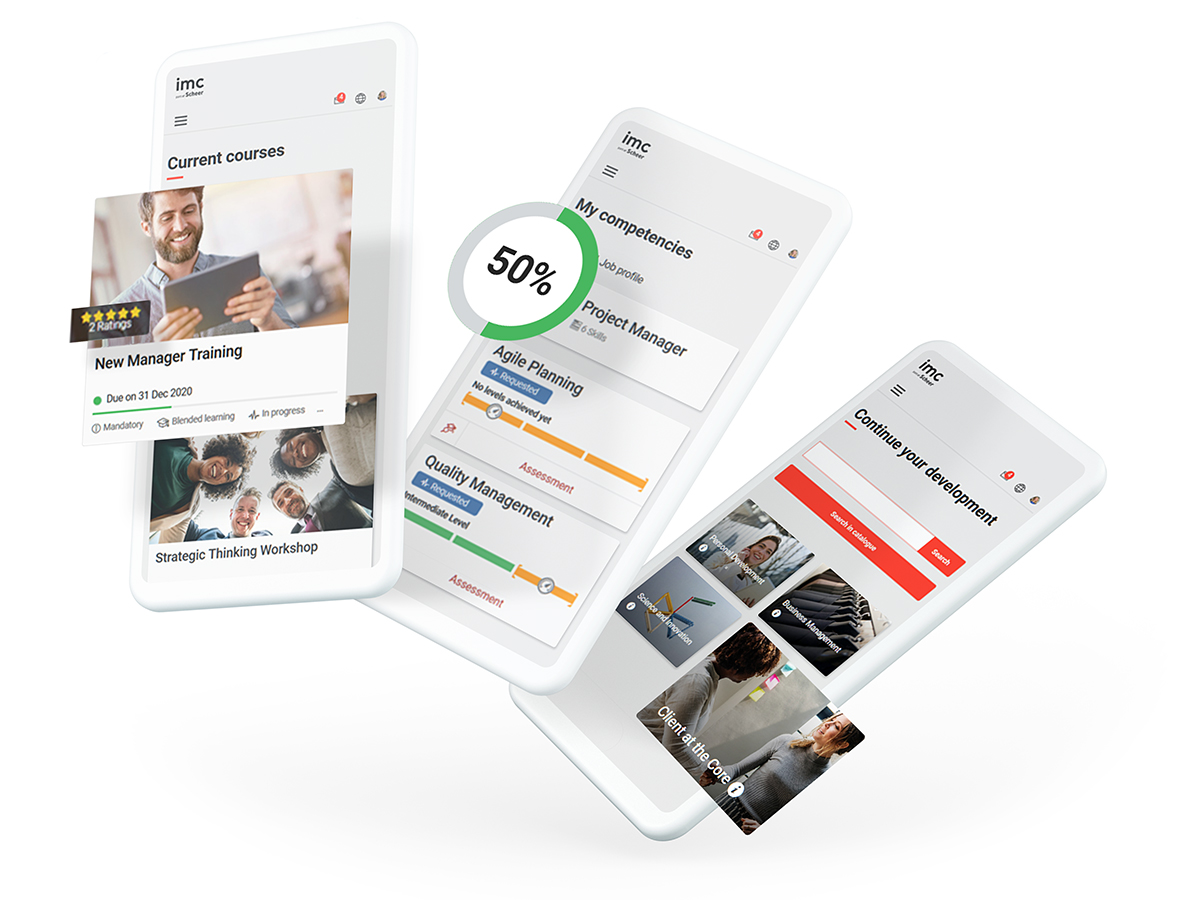
Learning to learn: Get rid of learning types, come up with learning strategies!
The best learning strategies for a successful school period
Learning has to be learned! We learn all the time, throughout our lives. Sometimes learning happens by itself when it is about content that interests you. Other topics, however, are more difficult. Pupils and students in particular are faced with the challenge of learning what is on the agenda - this is not difficult with their favourite course, but even more so with other subjects. The right approach can help you to learn properly.
We are not talking about the classification according to learning types, which used to be popular to promote learning progress, but is no longer up-to-date. We are talking about strategies that help to learn learning. Learning strategies are methods that help to better process and consolidate knowledge. In our latest infographic, we have summarised which methods are available and how they can make the future learning outcome of students a complete success.

Infographik of the Month: Learning Strategies
Download and further information
The info graphic you can download for free as PDF.

Learning Nuggets - A little bit of knowledge
In our infographic we explain the advantages of Learning Nuggets and why they are ideal for teaching.

Digital competences on the web
We show which competences students should have in order to be able to work confidently with digital media in class and to move safely on the Internet.
Contact person
I have been working in the Marketing & Communication Team at imc since March 2019.
Communication, creative content and social media are my passion. "KISS - Keep it short and simple" is my credo.
To explain complex content in an understandable way and thus make the topic of e-Learning accessible to everyone is an exciting challenge every day.
Privately I love to read, play poker and travel a lot.
I am always happy to receive feedback or suggestions.

The Netflix Factor in Self-Directed Learning
How self-directed learning can be used in companies, what it adds, and where its limitations lie

Few things are exercising the minds of today’s L&D managers more than the question of how to give employees greater flexibility in their learning. This is part of a trend in many companies away from formal and towards informal learning. And from informal learning, it’s just a hop, skip and a jump to self-directed learning.
Self-directed learning, in a nutshell, is about giving employees the flexibility to decide for themselves what, when, where and how they learn. That sounds simple, but it actually requires a great deal of conceptual design work and careful technical implementation, not to mention trust in one’s employees. But it’s worth it because, planned properly and implemented strategically, self-directed learning can be a valuable complement to classic top-down learning.
This key fact is not lost on Mercedes-Benz Group AG’s Michael Temme and imc Learning's Marion Sander-Feld, who are currently working on ways of integrating new self-directed learning components and functions directly into the imc learning management system (LMS). In this article, we explain the benefits of self-directed learning, what its limitations are, and what Netflix has to do with it.
The case for self-directed learning
Given the current skills shortage, employee upskilling and professional development are matters of top priority for all companies, regardless of size. Automotive giant Mercedes-Benz Group AG is a case in point. Its approach to employee learning is guided by five key questions: what, who, where, how and when.
Mercedes is also looking closely at how face-to-face training can be translated into online learning. This requires new approaches because it is not possible to take analogue training digital without careful modifications and workarounds. Anything short of this will serve only to turn employees off.

Michael Temme, who manages innovation projects at Mercedes-Benz Global Training, is an expert on this. He has no doubt that for a training course to be effective, learners need to be able to see and understand how it is relevant to their work.
“We need to face the fact that what matters is not how much an employee learns, but how much they retain”, he says. “We know that learning content is more memorable if learners are able to apply their learnings immediately and are free to select the learning method that works best for them. People have to be able to decide for themselves what, when and how they learn. That’s why we use self-directed learning methods.”
No obvious benefit = no lasting learning
According to Temme, one of the major challenges with self-directed learning is that it requires both different skills and different (digital) systems from those required in conventional learning. For example, when trainers are in the same room as all the course participants, they can ask whether everyone has understood the material and, if necessary, can provide additional details or explanations.
This learning-reinforcing element is a lot more difficult to create in digital settings. To make up for this, Mercedes is employing a number of approaches, including the use of sharing and learning-specific networking (social collaboration) in the LMS.
Self-directed learning also requires employers to place a great deal of trust in their employees, in return for which the employees need to be extremely self-organized and highly self-motivated. The point is that employees will only feel motivated to learn in the first place if they can see that what they are learning is relevant and will benefit them in their day-to-day work.
Just as importantly, they will only retain what they have learned if they are able to apply and reinforce it in their day-to-day work very soon afterwards, as Ebbinghaus’s Forgetting Curve shows.
The Forgetting Curve produced by German psychologist Hermann Ebbinghaus shows that after 20 minutes, you will recall only 60% of a text you have learned. The loss of retention continues over time, so that after 60 minutes, you will recall only 45% of what you learned, and after 24 hours only about 34%. Long-term, you will retain only about 15% of the text you learned.
Paradox: More courses, poorer learning outcomes
Temme also notes that the vast amounts of digital learning content generated during the pandemic resulted in many learners feeling overwhelmed by the sheer volume of courses and unable to tell which ones were actually relevant for them. In other words, offering more courses does not necessarily lead to greater initial learning or long-term retention.
For this reason, Temme increasingly favours problem-based learning over classic ‘ready-made’ learning content. Learners engaging with a real-life problem or question can, by using the right social collaboration tools, for example, quickly and easily work their way towards a real-life solution with support from other learners and/or from experts.
By using social collaboration in this way and by learning in the moment of need, learners retain their learning for much longer. They progress from inert knowledge to understanding and, by applying that understanding immediately, they achieve specific competencies.
Netflix-style learning with channels
This leads into an important new feature that imc AG is currently developing for its LMS, the imc Learning Suite, in partnership with Mercedes: channels. The idea of channels is to make learning as easy as watching Netflix or YouTube: learners simply select topics they find interesting or that are relevant to their needs and are then presented with matching content recommendations.
It doesn’t matter what a topic’s form or scope is. The learner is shown everything that matches the topic: everything from short learning nuggets to in-depth explanatory videos to learner-made tutorials. The main focus, however, is on learning nuggets that are readily consumed as part of independent research and can be created without too much investment of time and effort on the part of experts.
These short learning units offer the added benefit that they can be quickly consumed in the moment of need and on the job, which leads to improved internalisation and retention of knowledge. Consequently, the learning outcomes are superior to those achieved in situations where employees first learn and then try to recall the knowledge months later when they need to put it into practice.

Users receive notifications whenever new content is added to the topics to which they have subscribed. Marion Sander-Feld, Head of Product Management for imc Learning Suite, explains: “Channels are topic-based containers. They are represented on screen by tiles and can contain various didactic learning nuggets, such as videos, links or PDFs. The scope is not limited to highly professional and expensive-to-produce training courses.
This is intentional, because we also want the channels to provide content that can be produced quickly in order to meet urgent learning needs. In providing this new feature, we also want to enhance the learning experience because making it faster and more intuitive to navigate the LMS and find the desired content significantly improves learning outcomes.”
By expanding the learning offering beyond the usual highly polished web-based training sessions and enabling all users to post their own learning content, channels will make learning a more bottom-up and accessible experience for all. This addition of user-generated content, which all subject experts will be able to create with ease, will help to reduce knowledge loss.
Limitations of self-directed learning
So far, so good. But as is so often the case, self-directed learning is not necessarily the one and only solution that’s needed. There will always be content that employees are loath to engage with – courses on data protection, compliance or IT security, for example.
These are extremely important topics that require not just learning, but genuine internalisation, so it’s best not to leave that entirely to voluntary self-selection. But even with compulsory training like this, the managers responsible should still apply the problem-based strategies of self-directed learning.
Thus, if the topic is cyber security, the content should present concrete examples and real-life problem scenarios that show employees how they can help prevent cyberattacks. And if this approach works with less-than-popular courses, it is sure to be a major success when it comes to self-selected content. Because learning should be like watching Netflix: child’s play.

Diary of an LMS
If an LMS wrote a diary - what would it say?
We thought about that and share some tips for LMS professionals, told a little differently...

Informal learning: Everyday hero of work
“Formal learning is like riding a bus. Informal learning is more like cycling.” We explain what this means and share some key facts and recomemndations

More about our LMS
If you would like to learn more about imc's Learning Management, check here for more information.

Contact person
I have been working in the Marketing & Communication Team at imc since March 2019.
Communication, creative content and social media are my passion. "KISS - Keep it short and simple" is my credo.
To explain complex content in an understandable way and thus make the topic of e-Learning accessible to everyone is an exciting challenge every day.
Privately I love to read, play poker and travel a lot.
I am always happy to receive feedback or suggestions.

Delivering Measured eLearning Results
Here we look at how to plan successful eLearning that will transform results across your organisation - and it all starts with defining your training needs in the context of wider business goals.
Get the planning stage nailed, with buy-in from all your stakeholders (including your learners), and the rest can fall into place and feel like a breeze.
The problem with many eLearning projects though - as with many technology projects - is that so many people leap straight into choosing the solutions before they’ve really identified and agreed on their current and future training requirements.
So here we’ll offer a step by step guide to successful eLearning for L&D managers so that your colleagues and learners will love you.

eLearning is Now an Expectation
eLearning is now a common way for organisations to deliver training and your employees are likely to have used it in some capacity - even if it’s just during their education or a company onboarding process.
It has now evolved into a standard way of making training content available any time and anywhere, enabled by ubiquitous internet access by mobile or WiFi, and by websites or learning platforms making it accessible on phones and tablets, as well as a desktop computer.
During and post-pandemic, eLearning will be the only way for training to happen at all for many organisations.
So as there are now fewer barriers to delivering eLearning and it has become so important, here are key steps for making it effective:
1. Needs Analysis and Consultation
Arguably, this is the most important part of an eLearning project, because if done well, it gets everyone on board to help you and gives you the reasoning and structure for every subsequent stage.
- Why this project? What are you looking to achieve? If you have eLearning in place already, what improvements are you looking for, and if you don’t - what do you want this project to bring?
- Is eLearning suitable? Usually, the answer is yes - as knowledge-based content allows learners to consume it at the time, place and pace that suits them. However, for some manual / skills-based roles, it may not be the case, so could traditional, face to face training or a mix - blended learning - be the best choice?
- Cost-benefit analysis - what might this project cost and what are the expected business benefits in terms of cost-saving, efficiency or revenue generation?
- What do your learners want and need? Listen to their views on knowledge and skills gaps, and where there is an agreement, look at a bottom-up approach to complement top-down from L&D and HR management. If learners feel that they have contributed to the process, they are much more likely to engage when the eLearning is ready.
2. Resourcing the Project
However small your L&D team, delivering an elearning project should always be a collaborative project and involve multiple professionals.
The same person may perform more than one, but rarely all of the roles below, so the L&D manager will need to resource at least the following:
Project Manager
Who will lay out the milestones and timescales and work to keep everything and everyone on track?
Subject Matter Expert (SME)
Depending on the nature of the training, the person or people who understand the subject and can lay out the curriculum and materials.
Instructional Designer
The person who can translate the content into the storyboards and course progression to help people learn in the most effective manner, with an understanding of what works in an electronic format.
eLearning Developer
The technician with the skills to turn the plan into the reality of an eLearning course, including text and images, audio, videos or any other media, along with the ability to track, measure and collate data on learner progress.
Unless you work within a very large L&D team, you’ll need to look outside your organisation and outsource some or all of the above roles. A specialist eLearning company will tend to have skilled professionals with experience in working well with clients or taking responsibility for the entire project efficiently.
So how do you choose the best eLearning company for your needs if you go down that route? Many will have slick sales professionals and showcase multiple awards, but what matters most is experience working with companies like yours.
If you are part of a large, global organisation, does the eLearning provider have experience at that scale and of multinational, even multilingual projects?
Do they have experience in your sector?
These details are much more important than a sales presentation!
3. Design & Development
Again, planning this stage in advance is key. Does your project need to run within a specific timescale or a particularly tight budget? Both these factors will affect the nature of the eLearning that is feasible.
What mode of delivery is most suitable for the nature of your training and your group of learners? Text and images might work well for purely informational content and knowledge retention, whereas training the ability to adapt to on-the-job situations like customer service may lend itself to scenario-based training and something more interactive.
Close collaboration between the subject matter expert and the instructional designer will allow for the content to be delivered in the best possible way while adhering to any technical constraints.
The instructional designer then needs to work closely with the eLearning developer to bring the content to life, ensuring that it works well on any device that may be used and that it is accessible for any type of current or future learner.
4. Quality Assurance
An important point here is that quality assurance (QA) is not a task to be done only by the developer as a final step. Good QA is done independently by someone external to the design and build process, as those people may have become too close to see all the potential real-life issues.
Ideally, the project managers, SMEs, and end-user managers and even selected learners will all have the opportunity to offer feedback on eLearning before it is signed off and rolled out.
5. Roll Out & Implementation
Most technology-related projects that fail do so not because of an issue with the product, but with the communication and implementation process.
New systems often turn up as yet another piece of work - something else to think about and squeeze in around the existing workload.
If there was adequate consultation at all levels during stage 1, the implementation of eLearning should arrive not as a surprise and even as a welcome addition, because the benefits to learners and managers will have been communicated and expected.
Rather than having to convince employees to engage with your new eLearning, the focus can be on guiding learners and managers in how to make it work well for them.
6. Measurement & Evaluation
How will you measure the benefits of your eLearning project?
What metrics will the L&D team measure to judge effectiveness?
What metrics do other stakeholders care about?
Along with your own learning outcomes, taking the targets of other departments into account will help to make this a more collaborative and successful eLearning project.
Don’t neglect subjective feedback alongside the quantitative results in terms of learning outcomes and business impact. How much your learners enjoy and engage with the training is an important factor when looking at how well it will work for future learning needs, and what you might want to change or tweak.
All eLearning projects are unique, but by following each of the six key steps above, you can help to minimise the common risks and maximise the benefits and overall success.

How much does an LMS cost?
How much does a Learning Management System cost? And which will appear after the implementation? We share some insights and explain, what these questions have in common with buying a house.

"The users decide whether or not a learning offer is successful'
"The goal of a learning platform must be to help people do the tasks in their job better," says Uwe Hofschröer from Learning Strategy Consulting at imc. In the Job Slot, he explains what he means by that.
Contact person

Increase Customers Live Time Value and Earn Their Loyalty
Here we look at how to improve customer service, retention, satisfaction and live time value with Customer Education.
Business leaders know that, on average, it is 5X more expensive to acquire new customers than it is to retain existing ones. Furthermore, it is usually far more profitable to upsell and cross-sell to existing customers than it is to simply increase your number of customers.
Customer education can be a powerful tool in helping you to build trust, retain existing customers and ultimately, increase customer lifetime value (LTV).

What is Customer Education?
Customer Education is learning content designed to engage new or existing customers and help them to maximise the effectiveness of your products and services.
When it's done well, it can help to reduce customer service calls and in turn, reduce costs. It can help you to retain existing customers, and even turn some of them into enthusiastic advocates of your brand.
Customer education, also known as customer training, is so important that, according to a Salesforce survey in October 2020:
“80% of customers say the experience a company provides is as important as its product or services.”
Customer education tends to be most relevant for product-based companies, whether that’s physical products or software. It can be of most benefit if your product:
- has a learning curve, where it’s common for customers to make mistakes or get stuck
- requires people to change existing behaviours
- generates frequent customer support calls
- is used by people with a wide range of needs or in diverse contexts
- is updated regularly with new features (very common in software)
- lends itself to cross-selling or upselling (customer education can be a great sales tool!).
While customer education can be delivered face to face, online training enables any time, anywhere learning that is accessible at the user’s convenience. The Covid-19 pandemic greatly accelerated the trend towards online, helping many companies to deliver up to date content even when face to face was not possible.
Online customer education provides greater opportunity to deliver training across multiple formats, including any of:
Video guides
Hosted on platforms like YouTube or Vimeo, or on your own learning management system (LMS).
Live or recorded webinars
Guide new, existing or potential customers through your product usage. When live, you can respond to any questions on the fly, and for those who want to watch it later, the recorded version can act as a useful, video-based FAQ resource.
Infographics
An engaging, fun way to present facts and figures in a creative manner.
Slideshows
A common way to quickly convert traditional, face to face presentations into an always-accessible digital format.
Games and quizzes
An excellent way for customers to test new knowledge and see if they need to return to materials or seek additional support.
Customer Education Benefits
This can greatly reduce the cost associated with large support teams and the frustration customers feel when waiting in queues.
Customers get up and running with your product quickly because they have learning materials to hand if, as and when they need it most.
A huge issue in the field of IT and software products, which inevitably come with some learning curve. Most IT implementation projects fail, not because of a weakness in the product itself, but due to inadequate customer training and in turn, user adoption.
The point at which customers are engaging with your product is often the best opportunity to highlight your related products and services. If you can win their trust in and enthusiasm for Product A and make the customer confident that they can use it, that’s a great time to draw their attention to Product B, C, D….
This is frequently the greatest benefit to a good customer education programme. A customer who is happy with your solutions because you helped them to maximise the value of it, is much more likely to renew or upgrade when the time comes.
So clearly, there are numerous benefits to making training available to your customers, but how to make this easy and cost-effective? That’s where a customer education platform can make things efficient and highly scalable.
Customer Education Platform Features
The best customer education platforms will help you to not only upload training materials to make them accessible online, but will offer a range of useful features and attributes that include:
- Integrations with popular software products like eCommerce payment gateways (such as PayPal) or CRMs (such as Salesforce) to reduce admin, while ensuring data security.
- Scalability: You’ll want your platform to handle a growing customer base, and not become a limiting factor.
- Multilingual capabilities - if you run an international company, you’ll want to make eLearning content available to customers in multiple languages
- User analytics: Data and reports will help you to learn what content and formats are engaging your customers and where people seem to struggle or switch off. This can help you identify weaknesses in your learning materials - or even the product itself. It can also help you to intelligently signpost customers to areas of your platform for additional support.
Well-designed training materials that are kept up to date and made available via a good customer education platform should be seen as an investment in customer success, retention and new business development, rather than just a cost.
Guiding users in making the most of your products should deliver increases in customer lifetime value / LTV, win you new fans, and strengthen the reputation of your brand.
Happy to help
For 25 years, imc Learning has created eLearning solutions for customer education and staff training at companies and public sector organisations across the globe.
Our clients include the likes of Deloitte, Vodafone, BASF and Audi.
If you’d like an informal chat about how we could help you leverage customer education to improve customer service and retention, get in touch with us here at imc Learning.

LMS for Membership Organisations
Make an effective LMS platform for your membership organisation with key features such as eCommerce, adaptive learning and analytics.

Learning Ecosystem: A Universe of Learning
Create a learning ecosystem in the LMS that promoted self-directed learning in the long term.
Contact person

The Rise of Learning and Development As An Essential Part Of Business Growth
imc together with Institute for Learning & Performance Asia Pacific conducted a forum to discuss how leading businesses in Australia connect their learning journeys to their wider organisational objectives. Five representatives from a diverse group of businesses participated in this highly informative conversation. The article is an edited version of the transcript of the forum.

Daniel Antman, Managing Director, imc Australia
As the head of imc Australia, Daniel has been actively developing and directly implementing successful go-to-market strategies, leading ISO implementations and driving customer relationship initiatives with international cross-functional teams.
"The C-suite executives who don’t engage in the learning and development, are putting their businesses at risk." Daniel Antman

Samantha Mathews, Head of Business Development, imc Australia, Moderator
Samantha has worked closely with a range of clients and stakeholders in the Government, Manufacturing and FMCG space and is well-positioned to deliver sophisticated learning projects and outcomes.
"For people to give feedback, they need to have valued you enough to think that you’re going to take that feedback on board. It’s the same when it comes to learning, people won’t give you the time of day if they don’t feel valued, or if they don’t feel like their responses will be taken seriously. " Samantha Mathews

Phoebe Tan, Former Head of Strategy, Growth & Innovation, The Australasian Institute of Mining and Metallurgy
The Australasian Institute of Mining and Metallurgy, a 129 years old organisation, has a significant history in supporting mining and resource professionals around the world, primarily in Australia and New Zealand.
"The culture of lifelong learning supports the overall organisational culture and the values they want to foster within the company." Phoebe Tan

Jeremy Kurtz, Education And Training Manager, NRL (National Rugby League)
The NRL is responsible for the education and development of coaches, referees, umpires, first aid people, the Club President and secretary treasurers etc. These are people who work across various contexts, such as community sport and elite sport.
"Instead of just going through the motions of a training program, we focus on how we can help our learners enjoy the experience and engage with it meaningfully. Because, the happier they are and the more positive the experience, the better the outcome for everyone." Jeremy Kurtz

Bill Jarrard, COO, Institute for Learning and Performance Asia Pacific
The ILP is a leading association — an institute that looks after the learning and development field. Currently, it is expanding into the Asia Pacific region.
"Companies that don’t have learning and development as a core principle and are not asking their people how they want to learn, risk losing employees to places more focused on L&D." Bill Jarard

Gerry Marcus, Associate Director, Learning & Capability, Colliers
Colliers is a leading diversified professional services and investment management company. Globally, it operates in 68 countries and the teams work collaboratively to provide expert advice to maximise the value of property for real estate occupiers, owners and investors.
"The challenge for learning professionals is to get stakeholders to see the strategic value of learning in the context of the values of the organisation." Jerry Marcus

Brad McLean, National Manager, Learning and Development, BlueScope
BlueScope is a steel manufacturing and distribution company based in Australia and with operations globally.
"People need to feel that their company is investing in them and their continued growth. This means we owe it to our people to keep upskilling them so that they’re prepared for the future as well." Brad McLean
The panel’s participants shared their experience to raise the importance of learning as a part of the organisation’s strategy including:
- How to ensure that top management embed learning in their strategy?
- What are the tips and advice for innovative learning that will transform an organisation?
- What changes do organisations need to make to deliver learning and development effectively?
- How to view the employee's learning journey as a future-proof way of working?
- What are the implications if organisations don’t embed learning properly?
- How to engage the board or management to understand the importance of learning and development?
The profile and importance of L&D is only going to continue to rise as boards, management, employees and other stakeholders understand that quality L&D programs are an essential part of their business and personal growth strategies.

Digital Learning for a Remote Workforce
When the act of learning becomes a habit rather than an intervention, individuals and groups begin to adopt learning as a way of being within their role.

Learning and Development - Driving Business Growth
Improving employee performance and achieving better financial results the primary objectives of learning in the digital era.
Contact


How much does an LMS cost?
Why good planning saves time and money when investing in a learning management system
Who actually needs a learning management system (LMS)? What should you consider in your planning? Above all: How much does an LMS cost?
It is questions like these that many decision-makers are looking at when seeking to professionalise and digitise learning in their company. That is reason enough to get to the bottom of it all.
If you ask a real estate agent how much a house costs in general, they will likely roll their eyes at you and bombard you with a number of questions: What location are you looking at? How many rooms? What size? With or without a garden? Are you looking to self-build and be actively involved, or would you prefer a turnkey house? Solid construction or prefab? How do you want it finished and furnished? Laminate or wooden flooring?
There is a never-ending stream of questions needing clarification. As you can see, quoting costs without considering the parameters is not reasonable or tenable.

Bernd Heischmann, LMS expert at imc Learning
The same applies to learning management systems. As LMS expert at imc learning, Bernd Heischmann helps customers find answers to such questions, and ensures that the chosen LMS maps all requested scenarios and meets the (future) requirements. It pays to remember, that miscalculations and unnecessary changes after implementations are far more expensive than an investment based on a thorough needs analysis.
But one thing at a time: We asked Bernd about the most common questions relating to LMS costs and his tips for implementation.

Hello Bernd! First tell us, what contributes to LMS costing?
You are always looking at one-off costs and recurrent costs. One-off costs include things like implementing a customised configuration or LMS adjustment. Then you need to link other systems. Similar to a house, the planning, design and set-up of an LMS also needs to be tailored to the user so that their needs are met.
Especially in the planning phase, there are often enormous differences between different projects. In many cases, an LMS with an extensive feature set can be used “as is” and configurations are limited to a custom set-up.
If necessary, modules can be added. However, many customers want their LMS to be 100% tailored to their specific requirements. In that case, it’s worth looking at customising the system. Of course, that is more expensive than implementing an LMS in line with the existing system standard.
It is also important to remember that the “interior design” of an LMS is an added cost – for things like creating attractive learning content.
A software-as-a-service (SaaS) solution also involves recurrent fees. Typically, usage fees for such an all-in-one package of system provision and cloud hosting are charged per user. Yet, even with an alternative on-premises solution where the LMS is hosted in-house, software maintenance and support represent ongoing expenditures and hosting costs are incurred in addition to the one-off licence fees.
How big does a company need to be for an LMS to pay off?
An LMS can be a worthwhile investment for companies of any size – from SMEs to large corporations. It just depends on how it is used for what purpose. For instance, many of our customers not only train their own employees, but also their customers and partners. This helps them retain existing customers and partners, increase loyalty and attract new customers.
Many create a business model whereby they offer targeted e-learning courses in their system to third parties for a fee. The LMS then pays for itself very quickly.
We should also remember that professional development has become a major focus for employees and applicants. A company can no longer get away with neglecting training for their employees. Regular up-to-date professional development is no longer considered an optional benefit, but an integral part of a modern corporate culture that should be expected.

How long does it take to roll out a learning management system?
The technical implementation of an LMS without custom programming or sophisticated interfaces takes roughly three months. Of course, this can vary depending on the scope of the project.
Then, you also need to factor in the time to select a suitable and viable LMS and develop an effective concept for introducing e-learning in the company. Costs can quickly explode if suitability issues are only detected after implementation, or the selected system fails to evolve with the company and becomes obsolete after only a few years.
What are your top tips for a successful rollout?
As stated earlier, careful planning is absolutely crucial. Anything you miss in the beginning could turn into a major expense later on. I would therefore advise thinking carefully about future plans and other potential ways to leverage the system. If add-ons and extensions are considered from the start, a modular system that is easy to upgrade might be the answer.
Modern LMS have many functions, but different companies need different feature sets. With a modular system, the functional scope needed at a given time can be selected, limiting costs. As requirements change, additional features can be added one by one.
Stakeholder management is another important aspect. An LMS rarely involves just a single department. It usually affects the entire company. It is important to get the buy-in of key decision-makers. Typically, you are looking at IT, Personnel Development and L&D, but you might also want to consult Sales and the Works Council.
My final tip: It is vital that sufficient relevant content is available, and that you start off with excellent learning content. When the first learners start using the system, it is an absolute must the learning content they find there is exciting.
Investing in a small number of flagship projects that really inspire your learners is well worth the effort. First impressions count, and a bad impression is hard to rectify. Among our customers, the current trend for flagship projects involves learning games in 2D or 3D environments that allow learners to explore specific worlds. These look and feel nothing like traditional e-learning courses and create a unique atmosphere. You can also choose to create your own learning content, leverage content libraries or purchase off-the-shelf learning content. Simply remember that making a good first impression is key to wide-spread acceptance of the system.
Thank you very much!

How not to break bad with validated processes in an LMS
What requirements must an LMS map for validated processes? And how does Breaking Bad fit here? Questions about questions not only the Pharmaceutical industry should think about.

Learning Analytics: It comes down to the right questions
Learning must not be an end in itself, but fit in the company’s business outcome: More and more managers are demanding this. We therefore looked at how L&D managers can meet this requirement with the help of Learning Analytics.

More about our LMS
If you would like to learn more about imc's Learning Management System, check here for more information.
Contact person
I have been working in the Marketing & Communication Team at imc since March 2019.
Communication, creative content and social media are my passion. "KISS - Keep it short and simple" is my credo.
To explain complex content in an understandable way and thus make the topic of e-Learning accessible to everyone is an exciting challenge every day.
Privately I love to read, play poker and travel a lot.
I am always happy to receive feedback or suggestions.

The Ultimate eLearning Jargon Glossary 2024
LMS, LXP, SCORM, WBT, EPSS, NGLE, CBT, ITS!? Lost in a world of elearning terms and abbreviations?
Digital learning is teeming with cryptic terms, many of which are not at all self-explanatory and have various, equally-confusing alternatives.
In this A to Z, we shed some light on the subject and have compiled a list of the most important terms and abbreviations in the field of e-learning in 2024.
Jump to a relevant section or scroll on to browse…
Adaptive Learning Systems (aka Intelligent Tutoring Systems / ITS)
Adaptive learning systems gather data on the learner's activities and use this to adapt the learning journey to the individual’s observed needs. Using algorithms, the system will deliver image based content to a visual learner and interactive content to a communicative learner, or advanced content to a learner showing expertise in the subject area.
API
The term API stands for Application Programming Interface. This is a tool that acts as a bridge between two software platforms, allowing them to communicate data with one another.
In the context of e-learning, an API can be hugely valuable by allowing your learning platform to communicate learner data with related business systems, such as your HR software or collaboration tools like Microsoft Teams. This saves time by reducing the need to duplicate the management of employee data across multiple platforms.
Authoring Tool
An authoring tool is software for making it easier to create e-learning content. This could include interactive applications with which text, graphics, sound and interactivity can be combined to form a piece of content. Authoring tools can be used to create simple presentations or WBT (web-based training), or with an advanced tool - a full interactive module. No programming knowledge is required for using an authoring tool.
Learn more about our own authoring tools:
Blended Learning
Blended learning uses a combination of online and in person training to deliver training. The term often also refers to a blend of instructional methods, pedagogical approaches and technologies.
More about blended learning advice on our blog.
Cloud Hosting
Cloud hosting is the housing of digital resources or applications across multiple servers, often across multiple data centres or even countries. This can help to reduce the risk of downtime from a single machine failure.
Also known as cloud-based hosting, this can be a highly effective way for organisations - especially large, multi-site operations - to ensure speed of resource delivery regardless of location, and to scale as needed without the potential limitation of a single machine.
Conversational Learning (aka Conversational Interfaces)
Conversational learning interfaces utilise the basic concepts of social learning to create an interactive learning experience. The chatbot guides the user through the learning material with a question and answer conversation between user and bot.
Emoji's are a key part of conversational learning. Used as a replacement for body language, emoji's provide the learner with the non-verbal cues that are missing from digital training tools.
Custom content (aka bespoke content)
Custom elearning content is developed specifically for the needs of any individual client, in order to best meet their current and future training needs.
The alternative is ‘off the shelf content’, which is typically lower cost and used to deliver quick, compliance-based training. This can be good for ‘tick-box’ kind of training in areas such as basic health and safety awareness.
However, if you’re looking to use e-learning to engage learners and drive performance in the context of your business, then custom content will tend to be much more effective.
Learn about the custom elearning content development services we offer at imc.
Digitisation, Digitalisation and Digital Transformation
Digitisation is simply the transfer of assets from analogue to digital. In the context of learning, this is often taking paper based training materials or face to face classroom delivery, and creating online learning media, which is often housed in an LMS.
Digitalisation is the tactical use of digital tools to improve business processes. For example, this could be analysis of employee or team data within a performance management system (or even just a spreadsheet), in order to identify skills gaps or improvements to training materials. Digitalisation could go as far as changing a business model - for example, a physical goods store moving to ecommerce or a training company switching to selling courses online.
Digital Transformation is the broadest move that happens as a strategic shift orchestrated by the highest level of management. It is a long-term, highly coordinated series of digitalisation projects that may need to overlap and interact with each other.
Digital Transformation can be a powerful modernisation of an organisation that enables it to find new efficiencies, adopt the latest and future technologies, and literally change the organisational culture.
e-Learning
This is what imc Learning is all about - the term e-learning stands for ‘electronic learning’. Also known as elearning without the hyphen and digital learning, the word dates back to the days of installing training software to your desktop computer from a CD-ROM.
Now though, e-learning tends to be seen as synonymous with online learning and mobile learning that’s available anywhere and any time.
Electronic Performance Support System (EPSS)
An EPSS supports just-in-time (JIT) learning. In contrast to formal learning, this takes place at the point of need. EPSS is typically deployed to support a piece of software and can either guide a user through a process or act as a JIT tool, on hand to provide support when needed. The user gains independence and confidence by efficiently learning new systems and processes without the aid of expert trainers.
Extended Enterprise
An extended enterprise means a company that needs to train, for example, franchisees, external service providers, brokers, their supply chain etc. Such training can be tackled strategically and efficiently by creating learning portals, customised for each type of audience, built into your LMS.
Game-Based Learning
The term Game-Based Learning refers to learning experiences that are delivered through the use of a game. A learning environment must be created that is attractive for the user, in which he or she can develop through positive, entertaining learning experiences.
More Game-Based Learning advice on our blog.
Gamification
This term refers to player motivation principles, such as rewards, to drive learner engagement. Gamification elements within training could be scores that are displayed to the learners and allow them to compare themselves with other players. Further gamification elements are badges and badges, which are awarded after completed tasks.
Gamification principles for motivation can be incorporated into training without the learning experience actually involving a game.
Instructional Design
This is a skill and process that combines foundational principles in learning psychology with the latest available technologies to design content for the best possible learning experience. Trends in recent years have moved towards learner engagement, as well as the effectiveness of content, helping people want to follow the training materials.
Multimedia content options, such as video that is now more accessible with ubiquitous, fast internet access, and principles such as gamification and games-based learning, are now key elements of the instructional design toolkit.
Modern e-learning software, such as our own authoring tools, allow L&D professionals and subject matter experts with no formal industrial design training to create effective learning content.
Interactive Learning
Interactive learning requires a greater level of learner involvement than the stereotypical, ‘click next’ e-learning experience. Interactive training content has been shown to bring better learning outcomes than a passive learner experience, as it tends to be more engaging and forces the learner to process information and put their learning into action.
Interactive Video
Interactive videos are films that allow learners to decide for themselves what they want to see next. The learner is thus not only a passive viewer, but actively determines what he or she sees and learns.
Learning Experience Platform (LXP)
The LXP is a relatively new concept that takes e-learning beyond a top-down, employer-led platform into being a more immersive environment where employees can explore what to learn next. This allows them to proactively develop their own knowledge and skills.
Many LXPs take principles of context exploration and recommendation engines from the likes of Netflix. They can be a key tool for large companies to encourage a culture of learning.
Learning Nuggets
A learning nugget is a short learning unit or a building block or a mini module in e-learning that usually lasts no longer than five minutes. The term is often used in connection with Micro-Learning.
Learning Management System (LMS)
A Learning Management System, (LMS for short) is software used to digitally host, manage and track learning content, which is typically assigned by tutors to their learners.
More about Learning Management Systems on our Learning Suite page.
Learning Content Management System (LCMS)
A Learning Content Management System (LCMS) is software that enables the creation, storage and management of reusable learning objects. It also enables web-based learning to be organised and maintained by multiple authors. An LCMS combines the functionality of an LMS and a content management system (CMS).
Learning Record Store (LRS)
A Learning Record Store is connected to an xAPI or Tin Cab and collects, stores and retrieves data and learning activities. An LRS can be integrated into an existing LMS.
Learning System Suite
The concept of the Learning System Suite is a combination of an LMS and LXP, as well as a NGLE.
It provides all the top-down training delivery and assessment capabilities associated with a Learning Management System (LMS) for the essentials of onboarding and compliance, combined with the intuitive and engaging environment of a Learning Experience Platform (LXP) and the broader ongoing training, collaboration and interoperability you might consider to be a Next Generation Digital Learning Environment (NGDLE) (or NGLE).
The imc Learning Suite is built for exactly this purpose - a solution for learning management, experience and performance all in one place, while integrating seamlessly into your existing tech stack.
Micro-Learning
Learning content is divided into small units or building blocks for the user to access as individual elements at any time. This flexible approach is also often termed as 'learning nuggets'.
Mobile Learning (M-Learning)
Mobile Learning refers to training accessed through mobile devices. This makes the learning experience more flexible and more independent of time and location.
Mobile Learning modules are typically designed primarily for a smaller screen size, especially phones, enabling any time, anywhere learning. This requires streamlined content that is less taxing on bandwidth, and a different approach to user navigation.
More about Mobile Learning on our blog.
MOOC
A MOOC (a Massive Open Online Course) is an online course aimed at a large number of participants and is usually free of charge. Pioneers of this format are Stanford University, the Massachusetts Institute of Technology (MIT) and Harvard University.
Multi-tenancy LMS
In the field of software, the term multi-tenancy refers to a single application (so in our context, the LMS) shared by multiple user groups who each experience their own, individualised learning environment. This means that different user groups can have different learning portals (each with its own entry portal, its own features, user rights, content, look & feel, etc.), while the system is centrally managed through a single LMS.
This can greatly reduce the cost and time needed to adapt the training experience for different teams, partner organisations, or even customers.
Read more about multi-tenancy LMS solutions in our in-depth article on the topic.
Next Generation Digital Learning Environment (NGDLE)
L&D professionals and industry commentators have been bemoaning the limitations of learning management systems and predicting their imminent death almost since they were invented. One of the key complaints is their closed nature that requires a great deal of additional administration alongside other business and HR systems.
The idea of the Next Generation Digital Learning Environment or NGDLE is that it opens up a learning and people performance ecosystem of tools with open standards and principles, perhaps with single sign on (SSO), which will greatly reduce the siloing of learning assessment, collaboration, feedback and general communication.
Some people drop the ‘Digital’ as a given, giving us NGLE.
Our own imc Learning Suite is an example of such an integrated solution that plays nicely with other popular business tech solutions.
On-site Hosting (aka on-premise hosting)
In contrast to cloud hosting where data can be stored on multiple servers, and possibly even across multiple territories, on-site hosting will house data at a single client location.
While data security has generally improved over the years and many organisations have moved entirely over to the cloud, on-site hosting can still be appropriate for some organisations where security is of extra concern, and / or to ensure compliance with specific industry or local regulations.
The downside of on-site / on-premise hosting compared to cloud tends to be reduced scalability as resource needs grow or the economies of scale associated with a company maintaining thousands of machines at one or more data centres, rather than a small number on-site. However, this is not a concern for some single-site organisations.
On-the-Job-Training (OJT)
On the Job Training refers to learning that takes place alongside activities at the workplace, and usually under the guidance of a colleague, coach or mentor or also through an EPSS. In colloquial terms, "learning by doing" refers to this type of training.
Performance Management System
A performance management system enables the ongoing, regular monitoring of employees against KPIs and individual targets. These targets and expectations will be set to support collective contribution towards the wider organisational strategy.
A good performance management system will include learning resources to help support individuals and give them data on their own performance, while providing a management dashboard so that L&D and HR teams can identify an issues, in order to offer additional support or intervention where needed.
The imc Learning Suite incorporates the functionalities of a Performance Management System in the LMS. With its extensive Learning Analytics modules, the imc Learning Suite provides both learners and tutors as well as managers with clear dashboards regarding the learner's progress and performance.
Predictive Analytics
The leading modern learning management systems can aid in the use of learner data to identify potential training requirements of individuals or certain groups.
Predictive analytics is a foundation of adaptive learning systems and learning experience platforms.
REST API
API (Application Program Interface) as explained above is a general set of protocols that enables various software to interact and communicate data between each other. REST API or RESTful API (Representational State Transfer) is a subset of this that deals specifically with web applications and is mostly used to handle HTTP requests.
SCIM
The abbreviation SCIM stands for System for Cross-domain Identity Management and is one of the open standards for managing user information across platforms. In the context of L&D and HR, it can greatly streamline IT tasks and reduce admin time when using cloud-based apps and services, as it allows your IT team to automate many repetitive tasks, such as employee details and learning requirements.
SCORM
The abbreviation SCORM stands for "Sharable Content Object Reference Model" which references the digital packaging of e-learning courses. Through this format, SCORM courses can be imported and launched through any SCORM compliant platform. Industry standard LMS all include SCORM players.
Serious Game (related terms: Adventure Game or Learning Game)
Serious games are not exclusively for entertainment purposes, but instead convey knowledge or skills through playful actions. See also: Gamification and Game-based Learning which aim to engage and motivate learners through adventures and competition.
Social Learning
Social Learning promotes an interaction between learners through sharing learning experiences. e-Learning can include social elements through comment functions, social media postings, instant messages, forums, wikis, video chats, etc. which can typically be integrated with modern LMS. In addition, virtual communities can be set up to exchange ideas, knowledge and new contributions.
More about Social Learning on our blog.
Validated Learning Management System (VLMS)
Many companies – for instance, in the food, pharmaceutical or medical sector – need to meet strict regulatory requirements such as FDA Title 21 CFR Part 11. These requirements include that all processes leading up to the production of a product have to be documented and verified at any time. This also applies to employee training, as it is an essential factor in the quality management process.
A Validated Learning Management System (VLMS) - like the imc Learning Suite - enables organisations to make their training processes compliant with these strict requirements. Read more about Validation and Validated Learning Management Systems here.
Video-Based Learning
Learning through videos is popular with both employers and learners as it can convey much more information than static formats in a short space of time, and can appeal to those who prefer visual or auditory content. Videos can be designed and animated in different ways to contextualise learning, or directed by real people - 'characters' - who guide learners through a topic. 'Explainer videos' can be highly effective for onboarding new staff and introducing new concepts.
An advanced use of video-based learning is the interactive video.
More about Video-Based Learning on the blog.
Web-based Training (WBT)
Unlike computer-based training (CBT), no specific software installation is required. Instead, with WBT, the user accesses learning materials via a website or online learning platform.
xAPI (also Experience API or Tin Can)
xAPI is often seen as a further development of SCORM. In principle, learning content and learning management systems (LMS) can exchange information with each other in order to record a wide variety of data and learning activities.
To this end, xAPI has redefined some of the basic practices for tracking learning experiences. The main difference between xAPI and SCORM is the type of learning that each participant can follow.
While SCORM is limited to recording online learning, xAPI can track almost any activity. Here xAPI provides a much more detailed view of learning progress, both online and offline.
Different learning methods that xAPI can track include reading a web page, attending an event, borrowing a library book, playing a game, blended learning, and team-based learning. The xAPI data is stored in a Learning Record Store (LRS).
Do you miss anything?
We hope we’ve shed some light on the most mysterious e-learning terminology.
Do you have any questions, additions or suggestions?
Feel free to contact us!

Convincing stakeholders for an LMS
The success of introducing a learning management system hinges on those responsible for the launch taking due account of their stakeholders - and not underestimating them. We have compiled some expert tips and a checklist to help you in convincing your stakeholders.

Stop boring software trainings!
Stop boring software-trainings! That is the mission of Sarah Hillmann, Trainings Specialist and Business Consultant. She has prepared a new way to train customers for using imc's Learning Management System (LMS).

More information about the LMS
If you would like to find our more about the Learning Management System of imc, please find all information here.
Contact
I have been working in the Marketing & Communication Team at imc since March 2019.
Communication, creative content and social media are my passion. "KISS - Keep it short and simple" is my credo.
To explain complex content in an understandable way and thus make the topic of e-Learning accessible to everyone is an exciting challenge every day.
Privately I love to read, play poker and travel a lot.
I am always happy to receive feedback or suggestions.

Learning ecosystem: A universe of Learning – why you need it, how you build it
Discovering new worlds of corporate learning
The L&D sector has largely reached a consensus: Customisation must play a bigger role in corporate learning. We must strive to democratise knowledge. The panacea needed to achieve these ambitious goals? A learning ecosystem. The focus is almost exclusively on soft factors related to the corporate and learning culture when establishing such a system, neglecting technological aspects.
Yet, suitable software such as a learning management system or learning experience portal is vital. Let’s take a step back to grasp what a system needs to achieve to map a meaningful learning ecosystem.
Inflexible systems and uniform learning paths for all employees are a thing of the past. Nowadays, companies face the challenge of creating a learning ecosystem that promotes self-directed corporate learning in the long term.
Such a system links various platforms and creates a clear structure for the different formats within a learning portal. The search function leverages all integrated systems, taking account of both internal and external sources.

Andreas Pohl, Director Research & Development at imc
So much to the theory. The question now is: What technical structure enables a learning ecosystem to meet all requirements and offer real benefits to the employees?
What role does a learning management system (LMS) or learning experience portal (LXP) play within such learning universe?
imc expert Andreas Pohl, Director Research & Development, leads the development of such systems. Thanks to his many years of experience, he is very aware of the hidden potential learning ecosystems offer.

Hello Andreas! What would a learning ecosystem look like in practice? Can you give us a specific example?
Let’s say we have an industrial client who manufactures special parts for large-scale equipment. All new employees and trainees must know how to use the equipment employed to make these parts.
They train on a training machine to learn the workflow. Now, it is possible to link this training machine to a learning management system (LMS). In that case, a new employee could log into the training machine with their personal identifier. Once they have mastered the workflow, the machine automatically transmits the training success to the LMS where the training is marked as complete.
This is then booked in the employee’s learning path or as learning progress – for instance, as part of their on-the-job training. Thus, the communication between the different systems makes learning easier. This example might be a little staged, but I think it illustrated the practical application of a learning ecosystem very well.
What does a learning ecosystem need to do to make learners use them?
Before you start thinking about a learning ecosystem, a suitable cultural framework must be in place.
As an employer, I need to motivate employees to use a system and allocate time for that purpose. At the same time, the user experience of the learning ecosystem (LE) must be structured in such a way that the employees enjoy using it, and make it easy for them to find relevant content.
A user will be far more likely to use the system when they can see an immediate and direct benefit. If that benefit is not obvious, you have lost.
How do you realise that from a technical perspective?
There are two approaches: First of all, I can make the LMS or LXP the central hub for my learning ecosystem. In this case, the LMS also needs to be able to present contents from external sources.
The learner can find materials from the entirety of the ecosystem through the frontend of the LMS. It makes no difference to them where learning content is stored – in the company LMS or, for instance, an integrated content library. For the learners, it is important that the system is easy to navigate and that they can quickly find relevant contents without jumping through hoops. Whether or not this takes them into a different system is irrelevant.
The second approach is to subordinate the LMS to the overarching portal. Rather than being at the centre itself, it delivers its results to the top level. This is useful when a central portal already exists and the LMS is integrated at a later stage.
How does an LMS become part of a learning ecosystem? What are the prerequisites?
In the second case – when the LMS is a cog in the wheel – the contents must be supplied to the overarching system. Indexing then becomes a major factor. That means that content must be provided in a format that triggers useful search hits presented and shown in a meaningful manner. The same applies to recommendations the system gives the user based on learning habits or interests.
Good APIs (application programming interfaces) are the key success factor for these types of functions. They facilitate the communication between the different applications. Effective and standardised interfaces are always important in IT, but whenever several systems come together, they become absolutely crucial.

How does an increase in content affect the individual interfaces and components?
This is a very interesting question. Let’s break it up into two parts. To illustrate: Your universe might grow because the number of planets is increasing, or because the existing planets are becoming more populated. These are two very different scenarios.
Similarly, you can expand your learning ecosystem by integrating or linking new components, or by adding more content to the existing elements.
After all, the purpose of a learning ecosystem is to continuously and frequently change the volume of the learning content, and the integration of user-generated content (UGC). Going back to our analogy, user-generated content merely increases population density on a given planet. From a technical perspective, this is not a critical process, as the growth takes place within an existing system with no effect on the complexity of that system. It would therefore not qualify as a true expansion.
So, what is “true” expansion? What do we have to watch out for?
I would say a true expansion of the ecosystem involves the integration of additional systems or a new interface. This expansion process is somewhat slower, as each new system needs new interfaces or gateways.
Each “planet” needs to provide the information within the LMS to the other “planets” – and ultimately the user – through standardised interfaces, and various APIs as well as an event bus are utilised for this purpose. Meanwhile, the central system must be able to absorb content and integrate it in its search function to make it accessible to its users.

How does the system know which content should be shown?
The system can only show content it knows. That means either the index content must be transmitted to the system – for example, via a data or event bus – or the system must have direct access to the index. Naturally, this can only work if indices are properly maintained and clearly structured.
What role does the data or event bus play?
An event bus is basically a messaging system. One system throws a message onto the bus, the bus takes off, and the next system can retrieve the message.
The message does not disappear after it is retrieved by one system – it remains available for the other systems. For example, systems A, B and C “take” the message, but system D ignores it, because it’s not relevant to it. Meanwhile, system D might “take” a different message that A, B and C are not interested in. Messages are thus distributed in real time, making manual message transfer to each system redundant (publisher-subscriber approach).
The challenge with this approach is that each system involved must be able to understand the message contents. This often requires some adjustments, as some systems might not be able to translate it directly. This is a major current topic for our development team.
What trends would you say can make learning ecosystems even better?
There is certainly room for improvement in system alignment, which also encompasses IoT (internet of things) and ESB (enterprise service buses). In other words, systems need to know both, which message they need to retrieve from the bus and which immediate adjustments they need to make.
This reduces the need for system adjustment. Now, an ESB is not a trivial thing, and might be overkill for a straightforward set-up with a small number of systems. However, my learning ecosystem is fairly complex and serves more than 10,000 employees, it makes an enormous difference.
Another thing we are working on at the moment is switching over to external contents. Right now, we can integrate external content in the search through our LMS, for example, through the LinkedIn Learning Content Importer. We want to expand that capability to enable the user to switch directly into the external system. We are currently collaborating with a major client to achieve that.
Finally, what should we pay particular attention to? Where do you see the most potential? Are there also disadvantages?
It comes at a cost. None of this is free. Everything we talked about needs investment. The systems need to be maintained continuously, as do the connections to the interfaces, and some of these systems might be proprietary. It’s not an automated process.
Ideally, that will enable me to create a learning ecosystem which optimises how the different needs of all my learners are met. Everything then comes from a single source, which is a whole lot more user friendly and actually feels like one system. A good learning ecosystem goes a long way towards improving the learner experience and providing real support to employees in their daily work.
My advice: Good planning is half the battle! It is important to clarify from the outset what you want to achieve, how many systems should be maintained and how much maintenance can be provided.

How not to break bad with validated processes in an LMS
What requirements must an LMS map for validated processes? And how does Breaking Bad fit here? Questions about questions not only the Pharmaceutical industry should think about.

Learning Analytics: It comes down to the right questions
Learning must not be an end in itself, but fit in the company’s business outcome: More and more managers are demanding this. We therefore looked at how L&D managers can meet this requirement with the help of Learning Analytics.

More about our LMS
If you would like to learn more about imc's Learning Management System, check here for more information.
Contact person
I have been working in the Marketing & Communication Team at imc since March 2019.
Communication, creative content and social media are my passion. "KISS - Keep it short and simple" is my credo.
To explain complex content in an understandable way and thus make the topic of e-Learning accessible to everyone is an exciting challenge every day.
Privately I love to read, play poker and travel a lot.
I am always happy to receive feedback or suggestions.

“The users decide whether or not a learning offer is successful”
It’s all about the people: Why introducing a learning management system is more than just getting another software.
“When companies introduce a learning management system, they need to understand that it is more than just another software. The objective must be to help people master the tasks they face in their job,” says Uwe Hofschröer, Head of the Learning Strategy Consulting Team at imc. In this role, he offers companies holistic advice on all aspects of digital learning.
He strives to place the employees at the heart of the offer, rather than the system or learning content. In this Job Slot interview, he also shares how he arrived at this job, and why he might as well be a note pad.

Uwe Hofschröer
Job | Head of Learning Strategy Consulting
Working in | Essen, Germany
Worked at imc since | 2017
Super power | Virtually interested in everything
Favourite food | Apple cake

Hello Uwe! Your job title sounds a bit like buzzword bingo. What exactly is it about?
The job title is rather abstract because it covers a broad spectrum of topics and tasks. The basic idea of learning strategy consulting is that we support customers whenever they face a more complex issue. Rather than offering advice on the introduction of a learning management system (LMS) or the key aspects of content development, learning strategy consulting focuses on the development of a holistic learning offer.
This is particularly relevant for companies making a fresh start with their digital learning offer and companies with little experience in this field. We help them consider all aspects and create a framework. Even larger companies will face new issues from time to time, and we then help them address these.
Can you give us a specific example for topics you get involved in?
Digital onboarding would be “our thing.” It is a fairly new topic for many companies. Of course, you can hire a concept designer to create a training course for you. The difference is that we are looking at the learner experience as a whole, rather than just the training course itself.
The learners are at the heart of the offer, and we need to start by identifying their needs. What content do they need? Which learning formats are suitable? How do these need to be designed? Next, we naturally examine how the training can be embedded in the LMS: How do we integrate it into the learning paths? How is the training presented? What interface does the learner see?
We are not restricting our evaluation to the content or the LMS but consider the entire learning journey. In a nutshell, learning strategy consulting covers traditional consultancy and needs assessments, analysis, and concepts design. We often support client projects for longer periods, coordinate the implementation or act as sparring partners.

Is your offer geared towards medium-sized companies or major corporations?
It’s not really clear-cut like that. Naturally, many SMEs never paid much attention to digital learning in the past and are keen to catch up now. Corona has certainly given many a big push in that direction.
However, many big corporations with a considerable track record in corporate learning and entire departments dedicated to learning and development are trying to move on from their focus on traditional face-to-face training. They might have employed the odd web-based training course, but now realise that this entire field is changing.
They will often lack experience or expertise in switching to hybrid or digital concepts and integrating them in a meaningful way. It’s also worth noting that attitudes towards proofs of learning success are changing.
The learning status “completed” only means that the learner has completed the training course. It offers no indication of whether the learner actually understood the contents or whether it will help them in their daily work.

How do you get a job like yours? What is your professional background?
Initially, I studied social sciences, aiming to do something in the field of journalism. However, I quickly realised that I’m not really cut out for that and took various courses in other fields as part of my degree. That also included technology, sociology and business management. In the early 2000s, I joined a research team examining what was a revolutionary subject back then: How universities can leverage the internet.
You could say that was my first venture into the world of digital learning, even if that term did not yet exist at the time. After this project, I took on a job as a concept designer with a professional development agency, where I initially created online and sales training, as well as early software training. After some time, I was given accounts that required me to support digital handbooks for car dealers. This gave me an insight into software projects and concept creation for learning platforms. I also learned how these platforms and courses are rolled out in large companies. It was a great learning experience.
Then, I joined imc. My background – especially the experience and insights gained with various customers and projects – helps me a lot in my current role.
I have to say that seven – or even five – years ago, I would never have thought that a job like this would exist. Back then, the professional development design and strategy was very much a company’s inhouse competence. However, the demand for multi-faceted consultations is increasing rapidly, not only for technological issues. The entire field of learning and development is quickly gaining ground – and complexity. It is difficult for companies to cover all the relevant aspects.

What do you especially like about your job?
It is always exciting and full of surprises. Each project and each set of customer requirements is different. There is very little routine. You need to engage with the customer and be tactful to find out what they need.
It also works in my favour that the job is very generalist in nature. I’m not a subject-matter expert. I know a lot of things in many fields, and somehow need to bring those pieces of knowledge together. All the different aspects – technical details of the LMS, different learning formats, change management processes – impact the learning culture as well as the corporate culture. We bring them together.
One thing that is extremely important to me, and I always try to convey to our customers is this: Neither a system nor a specific training course are at the heart of corporate learning. It is about the people. Employees want or need to learn something to do their job better. Their needs must therefore be a top priority.
After all, only the users decide whether a learning offer is a success or a failure. If they don’t see something that helps them, the offer is wasted.

That’s an interesting take! Now, I have some random questions for you. Ready? What is the most unusual thing you experienced in your job?
I found myself in a rather odd situation shortly before I joined imc. I was still working for my previous employer but had already handed in my notice and signed my contract with imc. My boss was aware of that, but the customer we had a meeting with that day had no idea. The purpose of the meeting? Helping them choose an LMS. Various providers pitched their solutions, including Sven R. Becker who is now on the imc Executive Board, but was Head of Sales at the time. While we both knew, the customer was unaware of my upcoming change of employer. Fortunately, the customer had to use a different tender procedure, so I was “off the hook” and did not have to make a recommendation on which system to choose.
Please complete this sentence: When dealing with colleagues, what matters the most is ...
... lots of communication, creating as much clarity and transparency as possible. While not always easy in practice, I also think a degree of composure, a reasonably relaxed attitude is important. We are all human. Mistakes happen and there has to be room for that. It’s OK. It’s part of the learning process.

What do you think your colleagues appreciate about you?
I would say my candour and my rather positive mindset.
If you could choose again, would you still decide on the same job?
Yes. It offers variety, is challenging and puts me in touch with many interesting people.
Sweet or savoury?
Savoury. I love my peanut puffs.
If you were an office supply, what would you be? Why?
I would likely be a note pad because it is extremely versatile. Note pads are also a great reminder that it’s worth keeping duplicates and older things. The mere existence of digital equivalents need not mean that they are better.
Thanks for the great insights, Uwe and all the best furthermore!

The crazy tech guy who wanted to be a Formula 1 driver
A little crazy, but also desperately in love with the LMS: That's Ravi Tandon, Customer Success Manager at imc Australia. He tells why he made the LMS his girlfriend and why he didn't become a Formula 1 driver.

Conductors of the Software Orchestra
The conductors of software and heroes behind the scenes: That's what product managers actually are. Like Lia Ghita from Sibiu, who as product manager is jointly responsible for imc's main product, the imc Learning Suite.
Would you like to know more about imc as an employer? Then take a look at our career section, maybe there is a suitable position for you.
We are also always happy to receive unsolicited applications!

Contact person
I have been working in the Marketing & Communication Team at imc since March 2019.
Communication, creating unique content and social media are my passion.
"One can not not communicate" - Paul Watzlawik.
To explain complex content in an understandable way and thus make the topic of e-Learning accessible to everyone is an exciting challenge every day.
Privately I love to read, play poker and travel a lot.
I am always happy to receive feedback or suggestions.

Learning Management Systems for Membership Organisations - Key Features to Look For
Here we look at the unique requirements you should look for in a learning management system (LMS) for membership organisations, in order to make your platform effective for current and future training needs, while improving many other aspects of member administration.
Over the last few years, many professional bodies and trade associations have added online training, services and member benefits via an LMS to supplement their offline offerings.
However, as everyone is becoming more tech savvy and comfortable in doing more of their business and social networking online, many membership organisations now conduct the majority of their communication via an LMS or online portal, with some even being primarily or entirely run online.
Add to this the need for social distancing and remote communication while the coronavirus pandemic continues through 2021, and many membership organisations need an online hub to be able to function at all.
Often, generic LMS solutions can technically be adapted to meet the needs of a membership organisation with some custom development work. However, choosing one that has this use case catered for by design (rather than being very focused on training internal company employees) can save a lot of hacking around and headaches.
At imc, our Learning Suite has been developed with membership organisations as a key user-type, making it easy for administrators to organise training, certifications, CPD / CE, online communication and much more.

LMS key features for a membership organisation
These are some of the key features we have worked to continually improve, and that we recommend you look for when choosing the best LMS for a membership organisation like yours:
CPD / CE
Many professional membership organisations require a level of Continuing Professional Development (CPD) / Continuing Education (CE) for members to demonstrate their commitment to staying up to date with the latest industry information and best practices.
Therefore, a good membership LMS will help both users to follow and record any points-based training, whether conducted online or offline, while enabling administrators to signpost suitable courses and content.
Social Learning
While the typical LMS for employee learning and development will be set up to deliver on the top-down training requirements in line with a company’s business and compliance needs, many people join an organisation for the benefits of expert instructor and peer to peer support.
Therefore, a membership LMS should facilitate group chats, threaded discussions, and many of the content liking, sharing and commenting features that users will be familiar with from social media platforms like Facebook, Twitter and LinkedIn.
Multi-Tenancy
Membership bodies, especially larger organisations, may have multiple types of learners, each with their own needs in terms of features, as well as content. For example, there will be the members themselves - who may form one or more type - there may be the organisation’s own staff who need training and their own ongoing support and development, and there may be external partners, such as affiliates and 3rd party training companies.
A multi-tenancy LMS like imc Learning Suite allows you to use a single learning platform instance to create distinct learning environments for each of your audiences. Each group sees only their self-contained learning experience, which can be tailored to their needs in terms of content, hierarchies, active features, and even branding.
Learn more about multi-tenancy here.

Low-Cost Scalability
Many trade associations and membership organisations, including some of our clients, have tens or even hundreds of thousands of members. Therefore, you’ll want to make sure your LMS can scale with you to large numbers of members without costs spiralling out of control.
Unlike online training for company employees, many organisation members will need to stay enrolled but may be relatively passive - perhaps not active at all for many months or longer.
Therefore, the pricing model used within an LMS for membership organisations should be tailored to or flex to reflect that lower level of resource usage seen within a typical corporate LMS that will be priced based on users / active users.
Software Integrations
Of course, there are many moving parts within a membership organisation, with training being just one of them. Admin time is therefore a potentially big expense, so management of member data should be as seamless as possible across software platforms for CRM, email, video conferencing, finance, multimedia content and more using APIs.
For example, imc offers easy integration with popular 3rd party applications such as PayPal, Shopify, GoToMeeting, Microsoft Teams, Linkedin Learning and Salesforce.
It’s this streamlining of software products that enabled the RIBA (Royal Institute of British Architects), who have 47,000 members worldwide, to go from 5 different systems for attendance bookings, training content, email notifications and more to managing everything within their LMS.
Adaptive Learning
Keeping content relevant and fresh is key for learner engagement with your content. Adaptive learning capabilities within your LMS helps to intelligently assess learners’ existing competencies as they progress through training content. It will guide them to what they need to learn and improve on, and reduce the repetition and frustration that can come from ploughing through training where they are already capable.
eCommerce
LMS ecommerce functionality enables a membership organisation to deliver self-service enrolment, and purchase of individual or group courses, event attendance and more.
For larger organisations especially, this can greatly reduce admin overhead and bring significant cost savings. Look for integrations with popular ecommerce payment gateways, such as PayPal and Shopify.

Virtual Conferences
Prior to the Covid-19 pandemic, many events were already moving to a hybrid model in order to reduce the need for travel and open themselves up to a much wider audience.
Having virtual conferencing capabilities within your LMS allows you to quickly and easily set up and deliver tradeshows and member events at a fraction of the traditional cost and logistics. They can even be recorded and made accessible for any timezone, and open up discussion forums in moderated groups.
Content Creation Tools
Specialist learning and development teams will often create elearning content with popular software, such as Articulate, and make it available within the LMS. However, a membership organisation will often have tens or hundreds of subject matter experts who could be sharing their valuable expertise with the community.
An easy to use learning content development tool, like our own imc Express, can enable experts with no formal learning design experience to create and share training materials all within the LMS ecosystem. This can greatly reduce the time and expense of rolling out new training.
User Hierarchies
A large membership organisation will often have various levels of management, and local area leaders governing and supporting members within their group.
An LMS that is purpose built with membership organisations in mind will allow you to easily create hierarchies with differing levels of permissions, reflecting your own organisational structure.
Analytics & Reporting
Many membership organisations will have one or more overarching objectives supported by projects and events running across a year. A good LMS will enable you to easily create custom reports, giving you clear visibility of progress against overall and group targets.
Detailed analytics will enable you to laser in on groups or individuals that need additional support, as well as high-performers who could be earmarked as future leaders.
How we can help membership organisations like yours
If you’re involved in the running of a membership organisation and are looking to improve training delivery or reduce the time and expense of managing multiple software platforms, then the above checklist of features could help you leverage an LMS.
With the imc Learning Suite, we’ve helped a wide range of membership organisations, such as the ACCA (Association of Chartered Certified Accountants) and the Australian NRL (National Rugby League) to manage many areas of their member administration - not just training - all within the single ecosystem of their LMS.
If you’d like to discuss how an LMS could benefit your organisation too, contact us at imc for an informal chat about your requirements.

Multiple portals, one system
A multi-tenancy LMS is a single learning management system instance that serves various learner groups with differing training needs.

Training external audiences
The concept of training external audiences like members, is often referred to as Extended Enterprise Training. But what is an extended enterprise?

